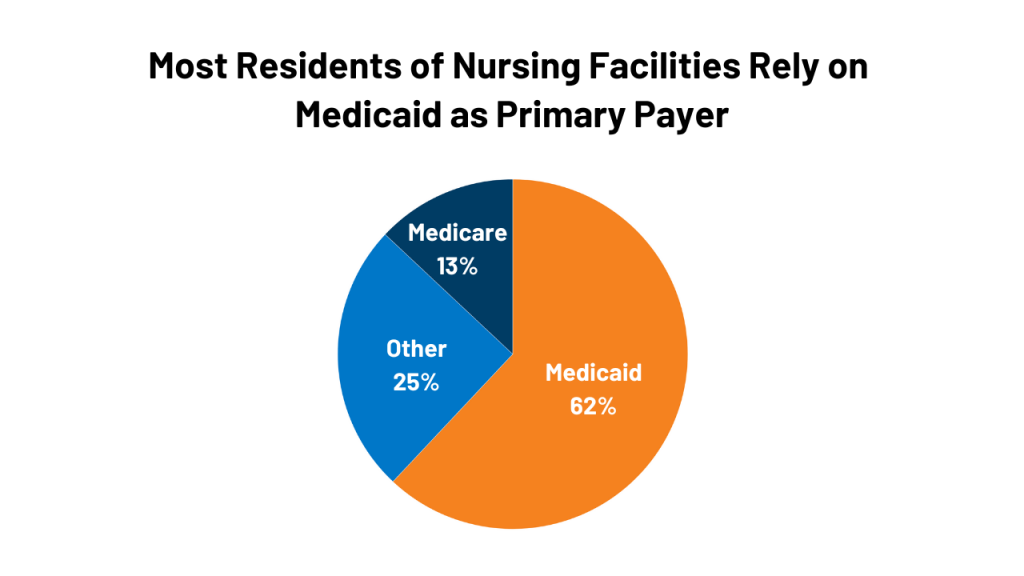
A Look at Nursing Facility Characteristics Through July 2022
The pandemic has taken a substantial toll on people living and working in long-term care facilities — they have accounted for more than one in five of all COVID-19 deaths in the U.S. During the pandemic, the number of residents living in nursing facilities that accept Medicare or Medicaid declined while the percentage of facilities reporting a deficiency that caused residents to experience harm or health risks increased. KFF recently updated nursing facility indicators such as occupancy rates and rates of harm/jeopardy through July 2022, which can help people better understand how the pandemic is affecting nursing facilities and the people they care for.
KFF creates the indicators with data from Nursing Home Compare, a publicly available dataset that provides a snapshot of information on quality of care in each nursing facility, and CASPER (Certification and Survey Provider Enhanced Reports), a data network maintained by CMS that compiles all data elements collected by surveyors during nursing facility inspections. This data note highlights several indicators from the July update to understand more about how COVID-19 affected nursing facilities. Users may download these data through State Health Facts, KFF’s data repository with downloadable health indicators at the state-level. Nursing facility indicators include the number of facilities, residents, beds, and nurse hours; and facility characteristics such as ownership, payer mix, and deficiency counts.
During the COVID-19 pandemic, the number of residents living in nursing facilities decreased by 13%, from 1.33 million in July 2019 to approximately 1.16 million in July 2022 (Figure 1). The number of certified nursing facilities and beds only decreased by 2% during that time. Decreasing resident counts and occupancy rates reflect longer-term trends as people increasingly opt to receive care in home and community-based settings over institutional settings. COVID-19 exacerbated that trend — in part because nursing facility residents and staffs incurred so many deaths during the pandemic.
During the pandemic, a higher percentage of nursing facilities received a deficiency for actual harm or jeopardy, but the average number of health deficiencies per nursing facility was relatively stable (Figure 2). Nursing facilities receive deficiencies when they fail to meet the requirements necessary to receive federal funding. Deficiencies are often given for problems which may have negative effects on the health and safety of residents. Commonly cited deficiencies include a failure to provide necessary care, failure to report abuse or neglect, and violation of infection control requirements. Deficiencies are characterized by their level of severity: Deficiencies for “actual harm” or “immediate jeopardy” are the most severe and are grouped together under the term, “serious deficiencies.” CMS defines “actual harm” as a “deficiency that results in a negative outcome that has negatively affected the resident’s ability to achieve the individual’s highest functional status.” “Immediate jeopardy” is defined as a deficiency that “has caused (or is likely to cause) serious injury, harm, impairment, or death to a resident receiving care in the nursing facility.”
Between July 2019 and July 2022, the percentage of facilities reporting a serious deficiency increased from 19% to 22%. That increase is likely attributable to violations of infection control procedures during COVID-19 outbreaks. Starting in 2022, facilities also incur serious deficiencies if they do not meet requirements for staff vaccinations against COVID-19 and 3 or more residents are infected with the virus. Meanwhile, the average number of health deficiencies per facility increased between 2015 and 2020 but remained constant over the course of the pandemic.
Other key nursing facility characteristics, including the share of residents by primary payer and share of facilities by ownership type stayed relatively stable, both prior to and during the pandemic (Figures 3 and 4). As of July 2022, Medicaid was the primary payer for 62% of nursing facility residents; Medicare for 13% of residents; and the remaining 25% of residents had another primary payer (ex. private insurance, out-of-pocket, etc.). Similarly, the share of facilities by type of owner has not changed notably overtime. As of July 2022, 71% of facilities were for-profit, 23% were non-profit, and 6% were government owned.
Looking ahead, the pandemic continues to impact nursing facilities with ongoing COVID-19 outbreaks and workforce shortages. Data from the Centers for Medicare and Medicaid Services show that just over one in four nursing facilities reported a shortage of direct care workers such as nurses and/or aides as of mid-July 2022. Data from the Bureau of Labor Statistics indicate that long-term care facilities, including nursing facilities, have experienced continued decreases in employment while other sectors of health care have recovered from workforce losses. These sustained shortages pose additional challenges for nursing facilities and residents and could potentially result in further increases in the rates of serious deficiencies.
In 2022, the National Academies of Sciences, Engineering, and Medicine released a comprehensive report on the quality of care in nursing facilities and recommended enhanced and updated federal staffing standards as one component of a wide-ranging package of nursing facility reforms. Since the onset of the COVID-19 pandemic, some states have adopted changes to increase state-level minimum staffing requirements. It will be important to watch whether and how lessons from the pandemic are integrated into new federal and state policies to improve nursing facility care quality and protect residents and staff.